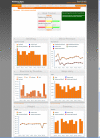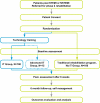A mobile phone-based care model for outpatient cardiac rehabilitation: the care assessment platform (CAP)
- PMID: 20109196
- PMCID: PMC2832776
- DOI: 10.1186/1471-2261-10-5
A mobile phone-based care model for outpatient cardiac rehabilitation: the care assessment platform (CAP)
Abstract
Background: Cardiac rehabilitation programs offer effective means to prevent recurrence of a cardiac event, but poor uptake of current programs have been reported globally. Home based models are considered as a feasible alternative to avoid various barriers related to care centre based programs. This paper sets out the study design for a clinical trial seeking to test the hypothesis that these programs can be better and more efficiently supported with novel Information and Communication Technologies (ICT).
Methods/design: We have integrated mobile phones and web services into a comprehensive home- based care model for outpatient cardiac rehabilitation. Mobile phones with a built-in accelerometer sensor are used to measure physical exercise and WellnessDiary software is used to collect information on patients' physiological risk factors and other health information. Video and teleconferencing are used for mentoring sessions aiming at behavioural modifications through goal setting. The mentors use web-portal to facilitate personal goal setting and to assess the progress of each patient in the program. Educational multimedia content are stored or transferred via messaging systems to the patients phone to be viewed on demand. We have designed a randomised controlled trial to compare the health outcomes and cost efficiency of the proposed model with a traditional community based rehabilitation program. The main outcome measure is adherence to physical exercise guidelines.
Discussion: The study will provide evidence on using mobile phones and web services for mentoring and self management in a home-based care model targeting sustainable behavioural modifications in cardiac rehabilitation patients.
Trial registration: The trial has been registered in the Australian New Zealand Clinical Trials Registry (ANZCTR) with number ACTRN12609000251224.
Figures



References
-
- National Heart Foundation of Australia, Report by Vos T and Begg S, Centre for Burden of Disease and Cost-effectiveness, University of Queensland School of Population Health. The burden of cardiovascular disease in Australia for the year 2003. 2007.
-
- Yusef S, Hawkins S, Ounpus S, Dans T, Avezum A, Lanas F, McQueen M, Budaj A, Pais P, Varigos J, Lisheng L. Effects of potentially modifiable risk factors associated with myocardial infarction in 52 countries (the INTERHEART study): case controlled study. Lancet. 2004;342:937–952. doi: 10.1016/S0140-6736(04)17018-9. - DOI - PubMed
-
- Balady GJ, Williams MA, Ades PA, Bittner V, Comoss P, Foody JM, Franklin B, Sanderson B, Southard D. Core components of cardiac rehabilitation/secondary prevention programs: 2007 update: a scientific statement from the American Heart Association Exercise, Cardiac Rehabilitation, and Prevention Committee, the Council on Clinical Cardiology; the Councils on Cardiovascular Nursing, Epidemiology and Prevention, and Nutrition, Physical Activity, and Metabolism; and the American Association of Cardiovascular and Pulmonary Rehabilitation. Circulation. 2007;115(20):2675–2682. doi: 10.1161/CIRCULATIONAHA.106.180945. - DOI - PubMed
Publication types
MeSH terms
LinkOut - more resources
Full Text Sources
Medical
Miscellaneous

